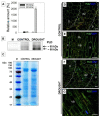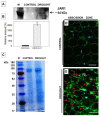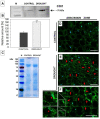Jasmonate-Dependent Response of the Flower Abscission Zone Cells to Drought in Yellow Lupine
- PMID: 35214860
- PMCID: PMC8877524
- DOI: 10.3390/plants11040527
Jasmonate-Dependent Response of the Flower Abscission Zone Cells to Drought in Yellow Lupine
Abstract
Lipid membranes, as primary places of the perception of environmental stimuli, are a source of various oxygenated polyunsaturated fatty acids-oxylipins-functioning as modulators of many signal transduction pathways, e.g., phytohormonal. Among exogenous factors acting on plant cells, special attention is given to drought, especially in highly sensitive crop species, such as yellow lupine. Here, we used this species to analyze the contribution of lipid-related enzymes and lipid-derived plant hormones in drought-evoked events taking place in a specialized group of cells-the flower abscission zone (AZ)-which is responsible for organ detachment from the plant body. We revealed that water deficits in the soil causes lipid peroxidation in these cells and the upregulation of phospholipase D, lipoxygenase, and, concomitantly, jasmonic acid (JA) strongly accumulates in AZ tissue. Furthermore, we followed key steps in JA conjugation and signaling under stressful conditions by monitoring the level and tissue localization of enzyme providing JA derivatives (JASMONATE RESISTANT1) and the JA receptor (CORONATINE INSENSITIVE1). Collectively, drought-triggered AZ activation during the process of flower abscission is closely associated with the lipid modifications, leading to the formation of JA, its conjugation, and induction of signaling pathways.
Keywords: CORONATINE INSENSITIVE1; JASMONATE RESISTANT1; abscission zone; drought; flower abscission; jasmonates; jasmonic acid; lipoxygenase; phospholipase D.
Conflict of interest statement
The authors declare no conflict of interest.
Figures






Similar articles
-
The acceleration of yellow lupine flower abscission by jasmonates is accompanied by lipid-related events in abscission zone cells.Plant Sci. 2022 Mar;316:111173. doi: 10.1016/j.plantsci.2021.111173. Epub 2021 Dec 29. Plant Sci. 2022. PMID: 35151456
-
Abscisic acid- and ethylene-induced abscission of yellow lupine flowers is mediated by jasmonates.J Plant Physiol. 2023 Nov;290:154119. doi: 10.1016/j.jplph.2023.154119. Epub 2023 Oct 17. J Plant Physiol. 2023. PMID: 37879220
-
Drought Disrupts Auxin Localization in Abscission Zone and Modifies Cell Wall Structure Leading to Flower Separation in Yellow Lupine.Int J Mol Sci. 2020 Sep 18;21(18):6848. doi: 10.3390/ijms21186848. Int J Mol Sci. 2020. PMID: 32961941 Free PMC article.
-
Four shades of detachment: regulation of floral organ abscission.Plant Signal Behav. 2014;9(11):e976154. doi: 10.4161/15592324.2014.976154. Plant Signal Behav. 2014. PMID: 25482787 Free PMC article. Review.
-
Arabidopsis jasmonate signaling pathway.Sci Signal. 2010 Feb 16;3(109):cm4. doi: 10.1126/scisignal.3109cm4. Sci Signal. 2010. PMID: 20159850 Review.
Cited by
-
Specific Roles of Lipoxygenases in Development and Responses to Stress in Plants.Plants (Basel). 2022 Apr 4;11(7):979. doi: 10.3390/plants11070979. Plants (Basel). 2022. PMID: 35406959 Free PMC article. Review.
-
Thidiazuron combined with cyclanilide modulates hormone pathways and ROS systems in cotton, increasing defoliation at low temperatures.Front Plant Sci. 2024 Apr 3;15:1333816. doi: 10.3389/fpls.2024.1333816. eCollection 2024. Front Plant Sci. 2024. PMID: 38633458 Free PMC article.
-
Exploring the response of yellow lupine (Lupinus luteus L.) root to drought mediated by pathways related to phytohormones, lipid, and redox homeostasis.BMC Plant Biol. 2024 Nov 6;24(1):1049. doi: 10.1186/s12870-024-05748-4. BMC Plant Biol. 2024. PMID: 39506671 Free PMC article.
-
Elucidating the Molecular Mechanisms of Physiological Fruit Abscission in Actinidia arguta Through Comparative Transcriptomics and Transient Genetic Transformation.Plants (Basel). 2025 May 28;14(11):1645. doi: 10.3390/plants14111645. Plants (Basel). 2025. PMID: 40508321 Free PMC article.
References
Grants and funding
LinkOut - more resources
Full Text Sources

